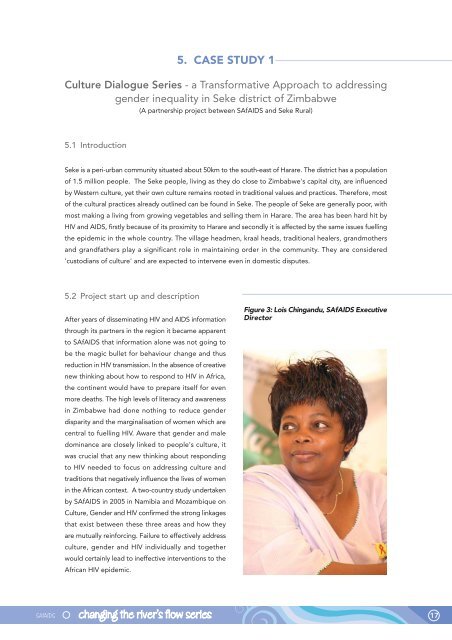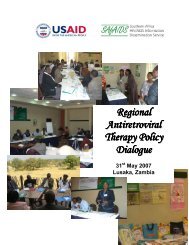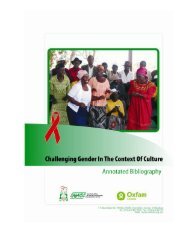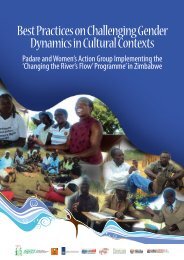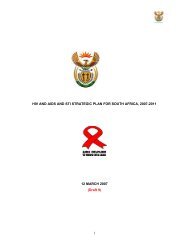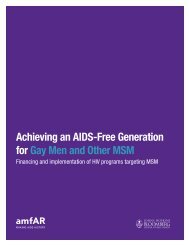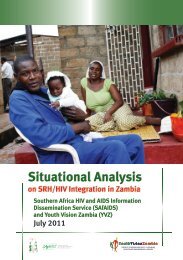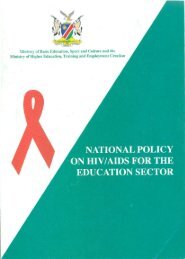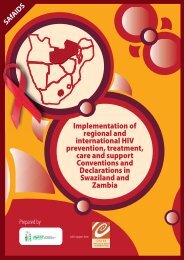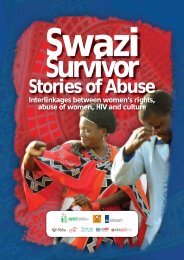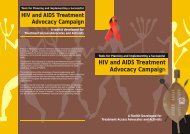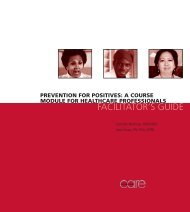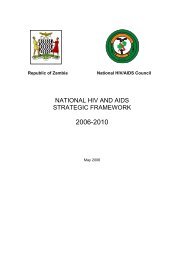Zimbabwean stories of "Best Practice" - SAfAIDS
Zimbabwean stories of "Best Practice" - SAfAIDS
Zimbabwean stories of "Best Practice" - SAfAIDS
You also want an ePaper? Increase the reach of your titles
YUMPU automatically turns print PDFs into web optimized ePapers that Google loves.
5. CASE STUDY 1Culture Dialogue Series - a Transformative Approach to addressinggender inequality in Seke district <strong>of</strong> Zimbabwe(A partnership project between <strong>SAfAIDS</strong> and Seke Rural)5.1 IntroductionSeke is a peri-urban community situated about 50km to the south-east <strong>of</strong> Harare. The district has a population<strong>of</strong> 1.5 million people. The Seke people, living as they do close to Zimbabwe's capital city, are influencedby Western culture, yet their own culture remains rooted in traditional values and practices. Therefore, most<strong>of</strong> the cultural practices already outlined can be found in Seke. The people <strong>of</strong> Seke are generally poor, withmost making a living from growing vegetables and selling them in Harare. The area has been hard hit byHIV and AIDS, firstly because <strong>of</strong> its proximity to Harare and secondly it is affected by the same issues fuellingthe epidemic in the whole country. The village headmen, kraal heads, traditional healers, grandmothersand grandfathers play a significant role in maintaining order in the community. They are considered'custodians <strong>of</strong> culture' and are expected to intervene even in domestic disputes.5.2 Project start up and descriptionAfter years <strong>of</strong> disseminating HIV and AIDS informationthrough its partners in the region it became apparentto <strong>SAfAIDS</strong> that information alone was not going tobe the magic bullet for behaviour change and thusreduction in HIV transmission. In the absence <strong>of</strong> creativenew thinking about how to respond to HIV in Africa,the continent would have to prepare itself for evenmore deaths. The high levels <strong>of</strong> literacy and awarenessin Zimbabwe had done nothing to reduce genderdisparity and the marginalisation <strong>of</strong> women which arecentral to fuelling HIV. Aware that gender and maledominance are closely linked to people's culture, itwas crucial that any new thinking about respondingto HIV needed to focus on addressing culture andtraditions that negatively influence the lives <strong>of</strong> womenin the African context. A two-country study undertakenby <strong>SAfAIDS</strong> in 2005 in Namibia and Mozambique onCulture, Gender and HIV confirmed the strong linkagesthat exist between these three areas and how theyare mutually reinforcing. Failure to effectively addressculture, gender and HIV individually and togetherwould certainly lead to ineffective interventions to theAfrican HIV epidemic.Figure 3: Lois Chingandu, <strong>SAfAIDS</strong> ExecutiveDirector17


